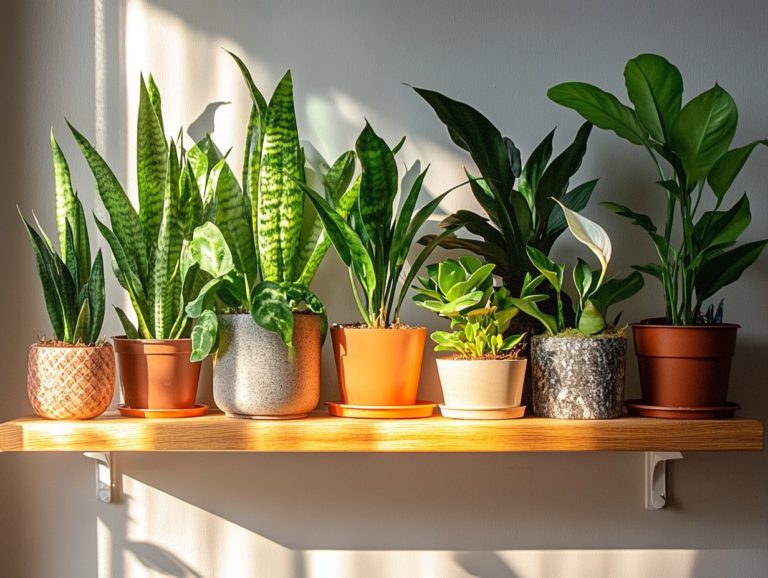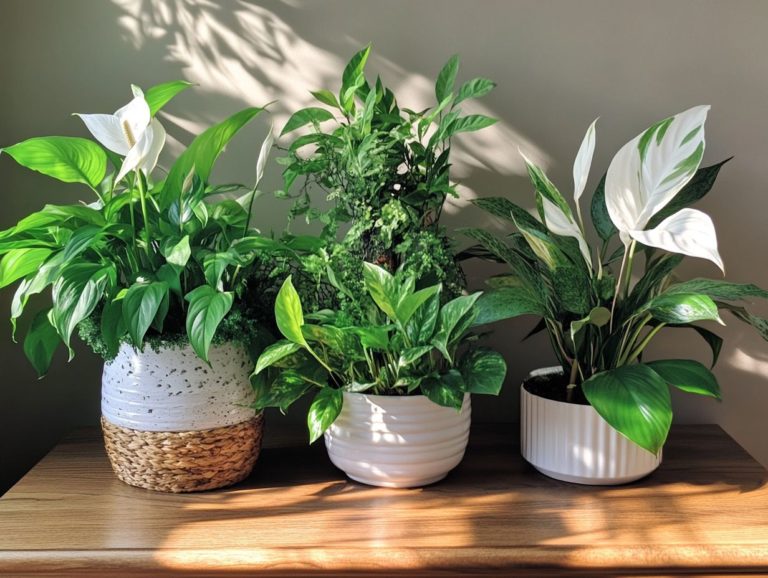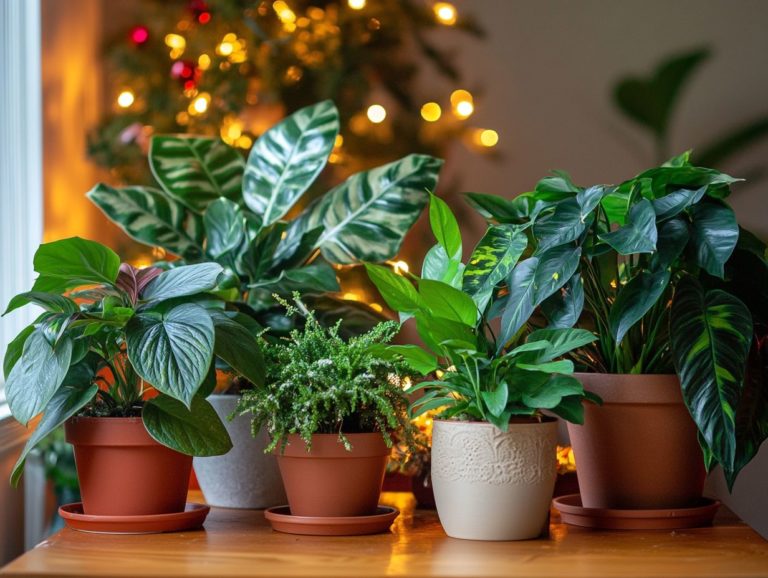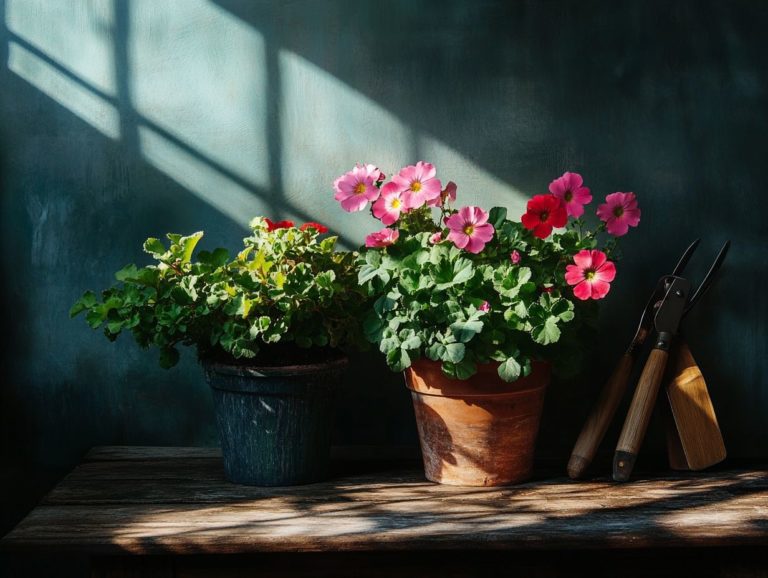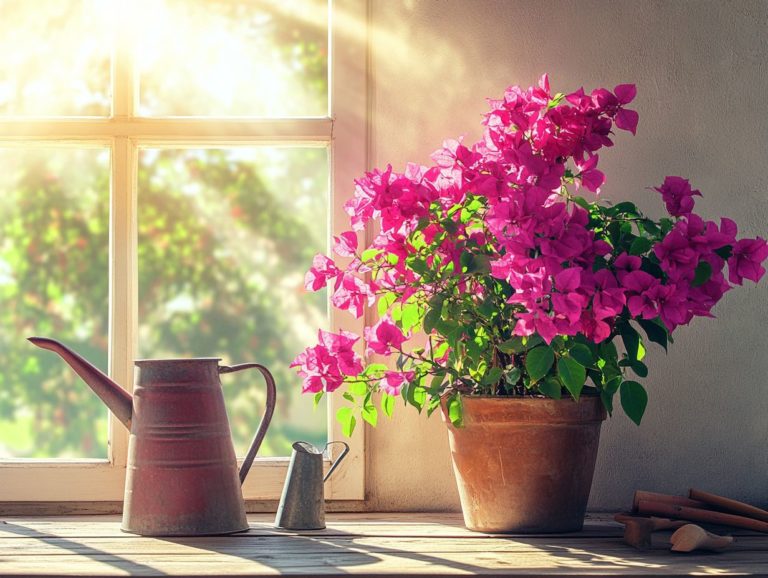Understanding the Dracaena Plant Care
Caring for a Dracaena plant might appear intimidating at first glance, but with the right information, you can cultivate a vibrant addition to your home.
This guide provides everything essential, covering ideal light and temperature conditions, effective watering and fertilizing techniques, and how to prune and propagate your Dracaena. You ll also identify common pests and diseases and troubleshoot any challenges that may arise.
Whether you re just starting out or have a wealth of plant care experience, get ready to discover valuable tips to elevate your journey in nurturing this exquisite plant.
Contents
Key Takeaways:
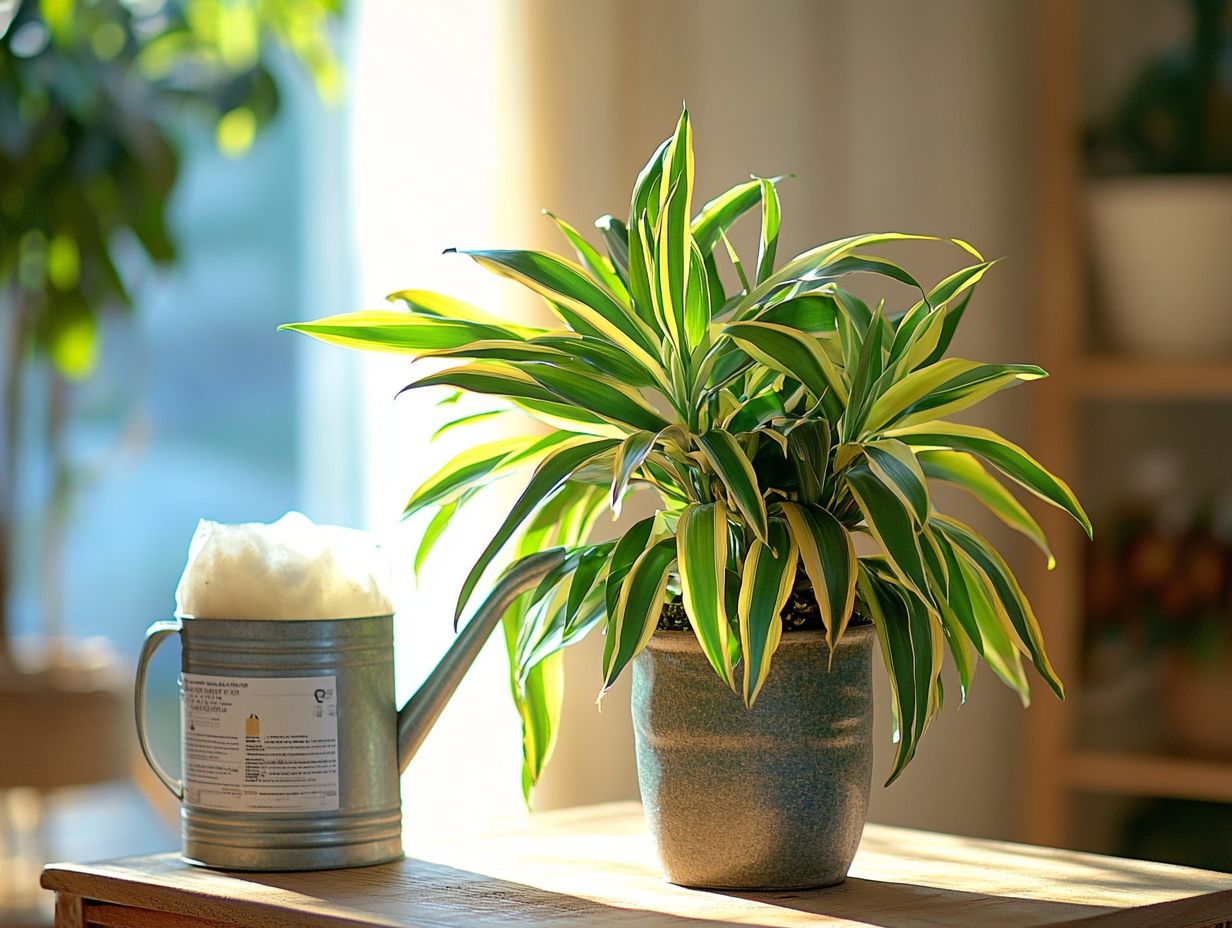
- Understanding the light, temperature, and humidity requirements of a Dracaena plant is crucial for its growth and overall health. Providing the optimal conditions will ensure a thriving plant.
- Proper watering and fertilizing techniques, along with a consistent schedule, are essential for the maintenance and growth of a Dracaena plant.
- Regular pruning and growing new plants from cuttings or seeds can help maintain and expand a Dracaena plant. It is also important to be aware of common pests and diseases and how to identify and treat them.
Overview and Common Varieties
In the world of gardening, houseplants like Dracaena are essential for enhancing indoor air quality while providing a touch of aesthetic elegance. Varieties such as the Corn Plant, Madagascar Dragon Tree, and Lucky Bamboo thrive in various indoor environments and contribute to a healthier living space. Renowned horticulturists Lynn McAlpine and David McKinney from Better Homes & Gardens stress the importance of understanding these plants, their care needs, and optimal growing conditions, making them invaluable companions for both novice and seasoned gardeners in any indoor or outdoor gardening space.
With their distinctive foliage and low maintenance requirements, Dracaena species like Dracaena Marginata, Dracaena Deremensis, and Dracaena Fragrans, along with Florida Beauty and Song of India, have become staples in contemporary homes.
Each of these varieties brings unique characteristics to your indoor spaces. The Corn Plant, with its broad, arching leaves, can reach impressive heights of up to six feet, serving as a stunning focal point. In contrast, the Madagascar Dragon Tree showcases a more slender and upright profile, ideal for smaller rooms. Lucky Bamboo, while not a true bamboo but a type of Dracaena, enchants with its twisting shoots, adding a touch of elegance.
Generally, these plants prefer indirect light and moderate watering, making them accessible choices for anyone looking to enhance indoor air quality.
Experts like McAlpine and McKinney highlight that these plants do more than just purify the air; they also uplift mood and overall well-being, reinforcing their significance in modern indoor gardening, especially considering the effects of indoor air quality.
Light and Temperature Requirements
Understanding the light and temperature requirements is essential for your success in growing Dracaena, the beloved houseplant celebrated for its resilience and aesthetic charm. These plants typically thrive in bright, indirect light but can adapt to lower light conditions.
Maintaining optimal temperatures, usually between 65 F and 80 F, is crucial for their health, whether you place them indoors or outdoors. For houseplant enthusiasts like yourself, mastering how to replicate these ideal conditions ensures that Dracaena varieties such as Dracaena Marginata and Dracaena Fragrans will flourish, adding vibrant green accents to any space you choose.
Start your plant care journey today and watch your Dracaena thrive!
Optimal Conditions for Growth
To ensure your Dracaena plants thrive, it s crucial to create an environment that meets their specific care requirements, particularly regarding temperature and humidity. These houseplants do best when temperatures hover between 65 F and 80 F. Humidity levels of 40-60% can significantly boost their growth.
By understanding the ideal conditions for Dracaena, you can cultivate healthy, vibrant plants that enhance your home s aesthetic and improve the air quality.
Maintaining these parameters can be tricky indoors, where temperature fluctuations and dryness often occur. To tackle these challenges, consider using a humidifier, especially during the dry winter months. Grouping your plants together can create a cozy microclimate that traps moisture, nurturing their growth.
Regularly misting the leaves or placing a pebble tray filled with water beneath the pot can also increase humidity levels. Keep your Dracaena away from drafts and heating vents to shield them from drastic temperature changes, allowing for consistent care that fosters an ideal environment for thriving growth.
Watering and Fertilizing
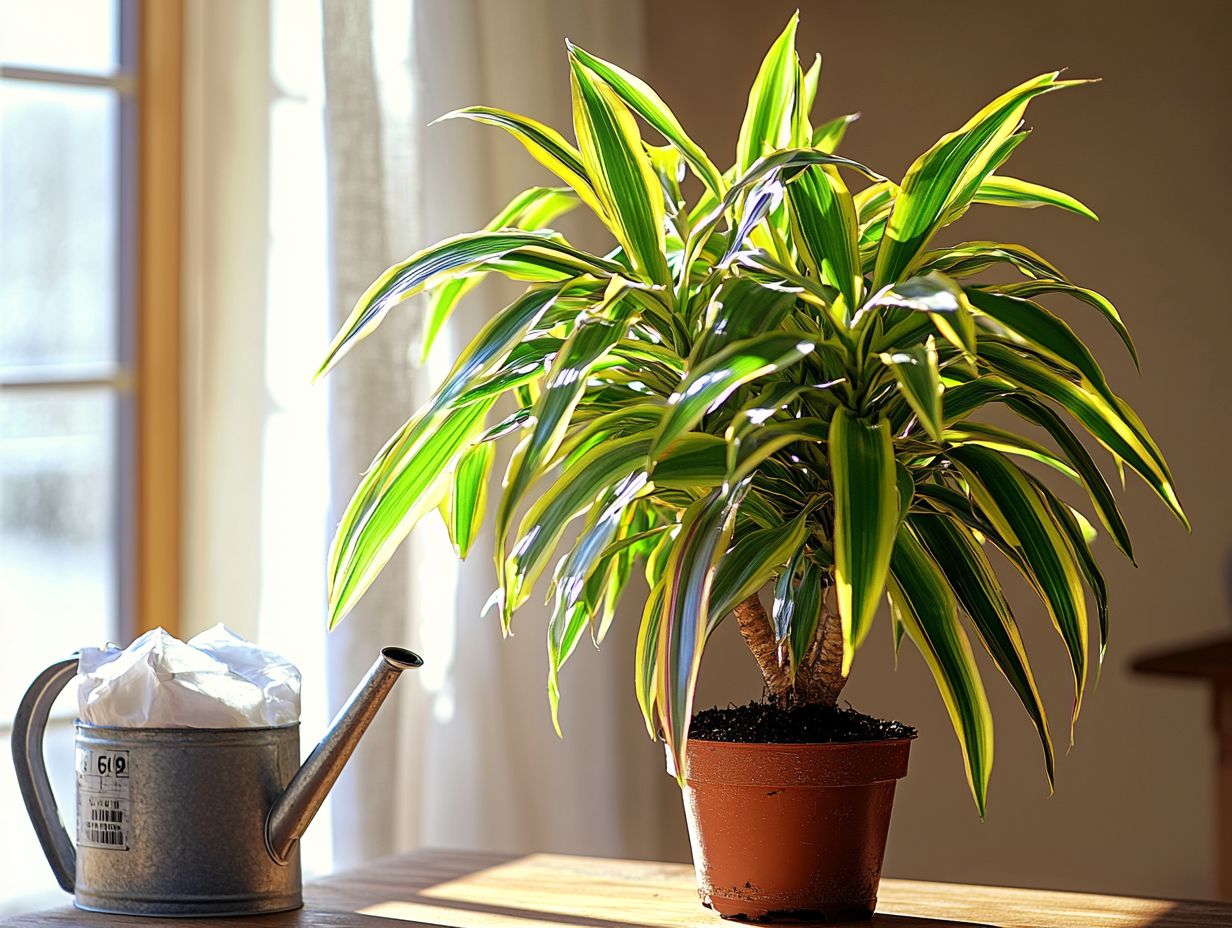
Effective watering and fertilizing practices are essential for the health and longevity of Dracaena plants, which require tailored care to truly thrive indoors. Be mindful that overwatering can lead to decaying roots due to too much water, while under-watering may result in wilting and stress.
Allow the top inch of soil to dry out between waterings, and apply a balanced fertilizer during the growing season. Understand these principles to help your Dracaena be it a Corn Plant or a Lucky Bamboo flourish in optimal conditions.
Proper Techniques and Schedules
Implementing proper techniques and schedules for watering and fertilizing your Dracaena is crucial for its growth and overall health.
Understanding the unique needs of this resilient plant is key to its success. Check the top inch of the soil for dryness before adding any water, ensuring the roots receive the right amount of hydration without becoming waterlogged. During the winter months, when growth naturally slows down, reduce watering to avoid overwatering.
For fertilizing, opt for a balanced, water-soluble formula diluted to half strength during spring and summer. Watch for signs like yellowing leaves or stunted growth; these could mean it s time to adjust your watering or feeding schedule. With a little care, your Dracaena will burst with life!
Pruning and Propagation
Pruning and propagation are essential elements of Dracaena care, enabling you to maintain plant health and foster new growth. By regularly pruning your Dracaena, you can eliminate dead or damaged leaves, enhancing the plant’s appearance and promoting improved air circulation.
Propagation is straightforward; simply take stem cuttings to expand your collection of Dracaena varieties, like Dracaena Deremensis and Dracaena Sanderiana. Mastering these techniques empowers you to ensure your plants thrive, keeping your indoor garden lush and vibrant.
Maintaining and Expanding Your Plant
Maintaining and expanding your Dracaena collection demands consistent care. Focus on both pruning and propagation practices to ensure their health and vibrancy.
Regularly inspecting for dead or yellowing leaves allows you to tackle any issues promptly. Employing proper pruning techniques enhances the plant s structure and encourages robust growth.
Utilizing propagation methods, such as stem cuttings, enables you to cultivate new plants from your existing ones. This enriches your indoor garden space with stunning Dracaena varieties.
To effectively assess your plants’ health, pay close attention to their overall appearance, including leaf texture, color, and growth patterns. If you notice sluggish growth or discolored foliage, this signals an urgent need for attention.
Keeping a consistent watering schedule and ensuring proper drainage will help you avoid root rot.
Regarding propagation, selecting healthy stems and making clean cuts is essential. Simply place the cuttings in water or a soil that drains well and provide them with indirect sunlight. This approach nurtures new growth and effortlessly broadens your Dracaena collection.
Common Pests and Diseases

Pests and diseases like spider mites, mealybugs, and root rot can threaten your Dracaena’s health. Stay vigilant to tackle these challenges.
Spider mites and mealybugs can invade your plants, resulting in yellowing leaves and stunted growth. Diseases like root rot can have a severe impact on their vitality.
Recognizing how to identify and address these issues is essential for preserving the health of your Dracaena. Ensure they flourish beautifully in your indoor garden.
Identifying and Treating Issues
Identifying and addressing issues related to pests and diseases in your Dracaena is crucial for maintaining their overall health and beauty.
Regularly inspecting your plants for signs of pests allows for timely intervention. Understanding symptoms of root rot, like wilting and a foul odor, gives you the power to take corrective measures before it s too late.
By learning to tackle these challenges head-on, you can preserve the vitality of your Dracaena collection.
It s wise to monitor environmental conditions, such as humidity and light, since these factors significantly influence plant health. Implementing preventative measures, like using insecticidal soap or neem oil, helps deter potential infestations before they escalate.
Troubleshooting Common Problems
Troubleshooting common issues like wilting and yellowing leaves in Dracaena plants is essential for maintaining their health and longevity. These symptoms often point to underlying conditions, such as overwatering, insufficient light, or nutrient deficiencies.
By meticulously evaluating the plant’s environment and care routine, you can effectively diagnose and address these problems, ultimately enhancing the growth and appearance of your Dracaena varieties.
Solutions for Wilting, Yellowing, and Other Symptoms
Wilting and yellowing in your Dracaena can come from different sources. It s vital to assess your plant s environment for the best care.
Common causes include improper watering, insufficient light, or a lack of nutrients. Luckily, specific steps can help your plant thrive once more.
-
Check your watering schedule. Both overwatering and underwatering can stress your plant. Make sure the soil drains well, and only water when the top inch is dry.
-
Observe the light conditions. Your Dracaena loves bright, indirect sunlight. If it s not receiving enough light, consider moving it to a better spot.
-
For nutrient needs, use a balanced, water-soluble fertilizer during the growing season. Regular pest checks can also boost your plant’s health.
Frequently Asked Questions
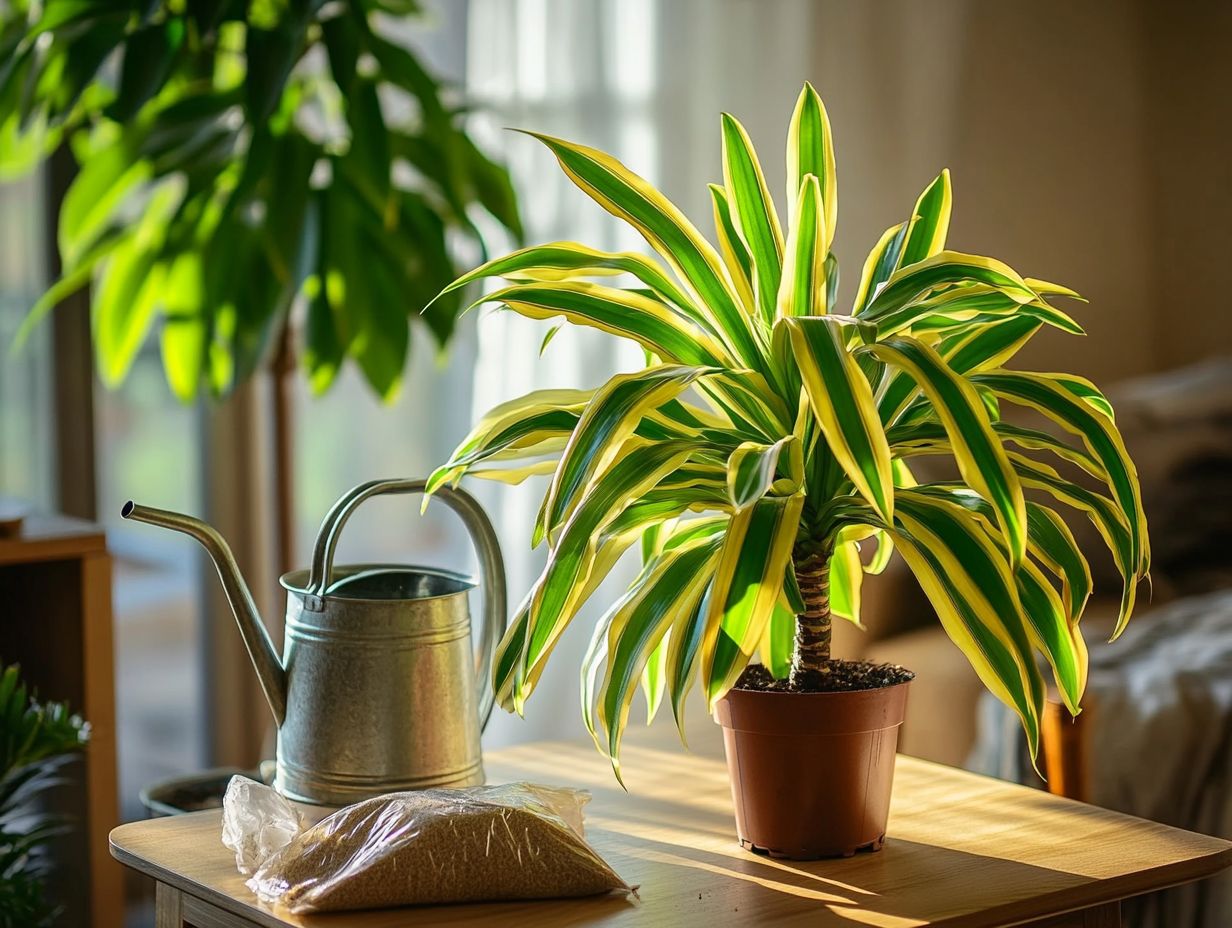
What is the best way to care for a Dracaena plant?
The best way to care for a Dracaena is to place it in bright, indirect sunlight. Water it weekly and use well-draining potting mix.
How often should I water my Dracaena plant?
Water Dracaena plants once a week. Let the top inch of soil dry out between waterings to prevent root rot.
Can I use tap water to water my Dracaena plant?
Filtered or distilled water is best for your Dracaena. Tap water can have harmful chemicals. If you must use tap water, let it sit overnight to reduce chlorine.
How can I tell if my Dracaena needs more light?
If the leaves turn yellow or droop, your Dracaena likely needs more light. Consider moving it to a brighter location or using a grow light.
Do I need to fertilize my Dracaena plant?
Dracaenas don t need frequent fertilization. Use a balanced, water-soluble fertilizer once a month in the growing season, following package instructions.
What if my Dracaena’s leaves turn brown at the tips?
Brown tips may indicate underwatering or over-fertilizing. Check the soil moisture and adjust watering. Consider repotting with fresh, well-draining soil to remove salt build-up.

